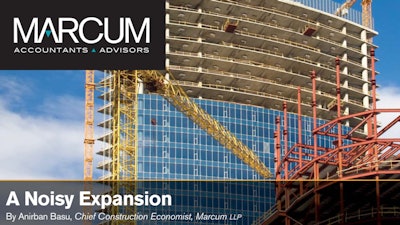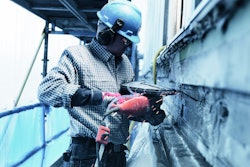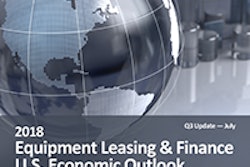
“A noisy expansion” is how Marcum LLP’s chief construction economist describes the second quarter of 2018, in the newest edition of the Marcum Commercial Construction Index. The index is produced by Marcum’s National Construction Services group.
Anirban Basu writes that the 4.2% increase in nonresidential construction spending during the quarter was short of expectations, as compared to the growth of the U.S. economy.
“Many factors have served to constrain construction spending growth, including a lack of available workers, weakness in a number of infrastructure construction segments, and growing concerns regarding over-valued and over-built real estate markets in certain parts of the country. It is also conceivable that the growing scarcity of certain construction materials is resulting in project delays,” he states.
Nonresidential construction subsectors losing ground in the 12-month period included Religious (-13.7%), Manufacturing (-5.7%), Educational (-5.5%), and Communications (-0.8%).
Among nonresidential segments experiencing year-over-year gains, the biggest increases came in the public sector: 20.2% in Public Safety, 17.7% in Water Supply, and 11.7% in Sewage and Waste Disposal. Double-digit gains were also seen in Transportation (14.5%), Office (10.8%), Lodging (10.7%), and Conservation and Development (10.4%).
The Marcum index for the second quarter noted the strong influence of the technology industry on construction growth: “That tech companies are driving commercial real estate and significant volumes of construction activity is hardly new… The specialized needs of tech giants tend to produce disproportionate levels of construction investment,” Mr. Basu noted.
“The ongoing strength of the tech sector is becoming increasingly important. That’s because many other segments of the economy are facing growing headwinds. There are few segments for which this is truer than for housing. With prices rising in the wake of shrinking for-sale inventory and with mortgage rates also edging higher, Americans are facing the worst housing affordability in about a decade. Meanwhile, builders are wrestling with higher materials prices, including softwood lumber, the price of which recently expanded 20% over a 12-month period,” he said.
The construction industry added 19,000 net new positions in July, with industry unemployment falling to 3.4%, the lowest level in 18 years. On a year-over-year basis, the industry added 308,000 jobs, an increase of 4.4%.
For the complete Marcum Commercial Construction Index, visit www.marcumllp.com/construction.


















